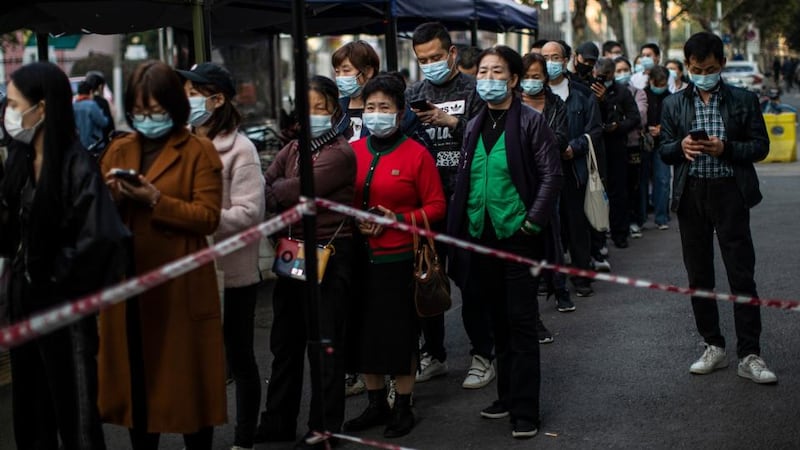The first known Covid-19 case was a market vendor in the Chinese city of Wuhan, not an accountant who appeared to have no link to the market but whose case contributed to speculation the virus could have leaked from a lab, a US researcher wrote in a commentary piece published on Thursday.
The origin of the SARS-CoV-2 virus that causes Covid-19 remains a mystery and a major source of tension between China and the United States. The new analysis by the researcher does not provide a definitive answer to that question.
A joint study by China and the World Health Organization (WHO) this year all but ruled out the theory that Covid-19 originated in a laboratory, saying that the most likely hypothesis was that it infected humans naturally, probably via the wildlife trade.

A WHO-led team of experts spent four weeks in and around the central city of Wuhan with Chinese scientists and said in a joint report in March that the SARS-CoV-2 virus had probably been transmitted from bats to humans through another animal but that further research was needed.
The accountant who was widely thought to be the first person with Covid-19, when interviewed, said his first Covid-19 symptoms appeared on December 16th, several days later than initially reported, Michael Worobey, head of ecology and evolutionary biology at the University of Arizona, wrote in the commentary piece in the journal Science.
“His symptom onset came after multiple cases in workers at Huanan Market, making a female seafood vendor there the earliest known case, with illness onset 11 December,” Mr Worobey said in the article.
He said most early symptomatic cases were linked to the market, specifically to the western section where raccoon dogs were caged, providing strong evidence of a live-animal market origin of the pandemic.
Mr Worobey was among the 18 scientists who had written to Science in May calling for an investigation into whether the source of the virus could have been a laboratory accident.
The WHO proposed last month a new expert panel to investigate the source of the coronavirus.
Japanese stimulus
Meanwhile, Japan’s cabinet has approved a record 56 trillion yen (€434 billion) stimulus package, including cash handouts and aid to ailing businesses, to help the economy out of the doldrums worsened by the coronavirus pandemic.
“The package has more than enough content and scale to deliver a sense of security and hope to the people,” prime minister Fumio Kishida told reporters in announcing the plan earlier in the day.
The proposal won cabinet approval in the evening, according to the prime minister’s office.
Mr Kishida has promised speedy action and parliament is expected to convene next month.
The plan includes doling out 100,000 yen (€775) each in monetary assistance to those aged 18 or younger, and aid for ailing businesses, Mr Kishida and other politicians said.
Japan has never had a full lockdown during the pandemic and infections remained relatively low, with deaths related to Covid-19 at about 18,000 people.
But the world’s third largest economy was already stagnating before the pandemic hit.
Under the government’s “state of emergency”, some restaurants closed or limited their hours, and events and theatres restricted crowd size for social distancing.
A shortage of computer chips and other car parts produced in other Asian nations that had severe outbreaks and strict lockdowns has hurt production at Japan’s carmakers, including Toyota, an economic mainstay.
Some critics have said the government approach amounts to “baramaki”, or “spreading out handouts”, which could prove ineffective in generating growth in the long run.
Others say the proposed cash aid leaves out families without children and other poor. The scale of the latest package will require Japan to sink deeper into debt by issuing bonds.
Japan has also promised to earmark spending for vaccine research after facing criticism over being dependent on imports for coronavirus vaccines.
It has so far approved vaccines from Pfizer, Moderna and AstraZeneca.
Mr Kishida, who has promised “a new capitalism” for Japan, took office in October.
Covid pill review
The European Union’s drug regulator said on Friday it has started reviewing data on Pfizer’s Covid-19 pill to help member states with possible use ahead of any formal EU-wide approval, days after the drugmaker sought US authorisation.
"While a more comprehensive rolling review is anticipated to start ahead of a possible application for a marketing authorisation, this current review will provide EU-wide recommendations in the shortest possible time frame," the European Medicines Agency said.
Pfizer this week applied for an emergency use authorization of the experimental tablet, Paxlovid, following data that showed it cut the chance of hospitalisation or death by 89 per cent in adults who are at risk of their illness worsening.
German weekly Wirtschaftswoche first reported on the EU review of Pfizer’s pill.
Elswhere in Europe, Vienna is bracing itself for a massive demonstration on Saturday against a three-week national lockdown from Monday to break a runaway fourth wave of Covid-19. Germany has also warned it may follow Austria in imposing a national lockdown.
United Kingdom infections
Covid-19 infections have fallen in most parts of the UK, though levels remain high, new figures suggest.
Around one in 65 people in private households in England had Covid-19 in the week to November 13, down from one in 60 the previous week, according to the latest estimates from the Office for National Statistics (ONS).
One in 65 is the equivalent of about 824,900 people.
The proportion of people in England who were estimated to have coronavirus at the peak of the second wave in early January was one in 50.
Wales has also seen a drop, with one in 55 people estimated to have had Covid-19 in the week to November 13, down from one in 45 the previous week.
Infection levels in Wales hit one in 40 people in late October, the highest since estimates began in summer 2020.
The ONS described the trend in Northern Ireland as "uncertain", with an estimate of one in 65 people in the most recent week – up from one in 75, but below the record high of one in 40 in mid-August.
For Scotland, the latest estimate is one in 95 people, down from one in 85 the previous week and below September's peak of one in 45.
All figures are for people in private households and do not include hospitals, care homes and other settings.
The number of Covid-19 infections in the UK, which is estimated every week by the ONS, is not the same as the number of new cases of coronavirus which are reported every day by the Government.
The average number of new cases of Covid-19 in the UK has been on a slight upwards trend in recent days, but it is too early for this to show up in the ONS data, which runs only to November 13th.
Any change in the long-term trend for infections could become clearer in future weeks.
Vaccination in Canada
Canada on Friday authorised the use of Pfizer Inc's Covid-19 vaccine for children aged five to 11, paving the way for the inoculation of elementary school-aged children across the country.
The shot is the first to be made available for young children in Canada. Officials had made clear for weeks that the decision would be favourable, noting that incidences of Covid-19 are highest in those under 12.
“After a thorough and independent scientific review of the evidence, the department has determined that the benefits of this vaccine for children between five and 11 years of age outweigh the risks,” Health Canada said in a statement.
Prime minister Justin Trudeau said last month that Ottawa had signed a deal with Pfizer to quickly receive 2.9 million doses of the vaccine once it was approved.
The US Food and Drug Administration authorised use of the vaccine for those aged five to 11 on October 29th. – Reuters/PA
*This article was amended on November 19th, 2021 to clarify that the claim of the virus’s origins was made by a researcher in a commentary piece in a scientific journal









